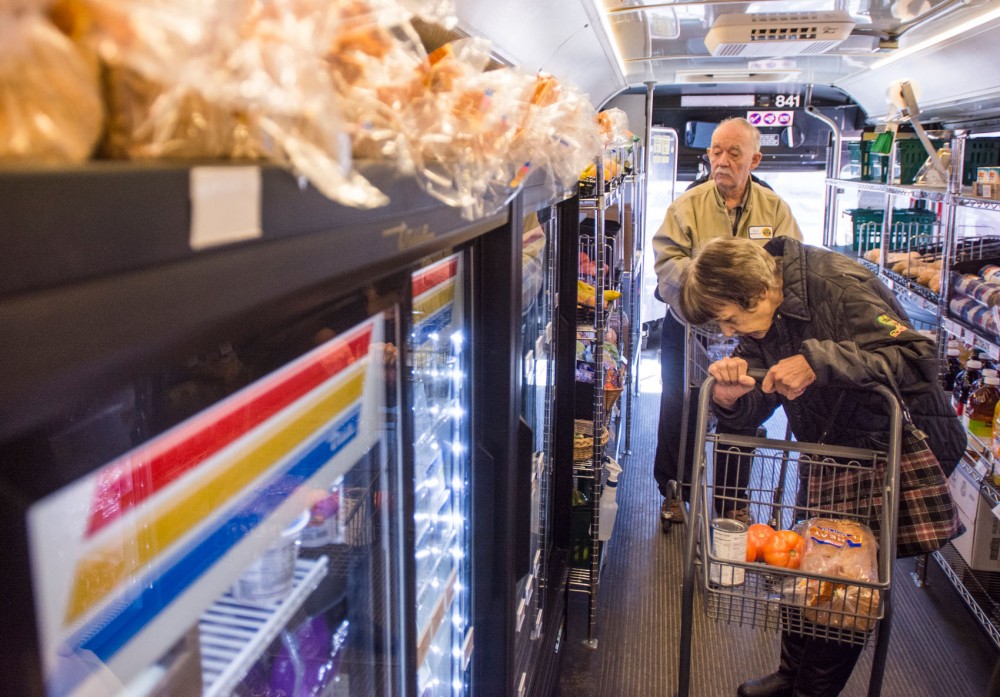For some St. Paul residents, a grocery store visit can mean a long trip through snow and wind. And the closest stores may not have affordable, healthy options.
One Metro Transit bus wrapped in bright green and pictures of fresh foods is trying to alleviate that problem by bringing healthy foods to low-income neighborhoods in St. Paul at a reduced cost.
The Twin Cities Mobile Market began operating under the local nonprofit Amherst H. Wilder Foundation in December.
According to University of Minnesota Extension data, more than 10 percent of adults and almost 20 percent of children in Ramsey County lacked food security in 2010. That means at some point during the year, they didn’t have access to or couldn’t afford adequate food.
The data also showed about 5 percent of residents qualified as low-income and lived more than one mile away from a supermarket or large grocery store in 2006.
That’s why Leah Driscoll, the mobile market’s program manager, said she began developing the program about two years ago.
Driscoll was studying different ways to address food insecurity throughout the U.S. for her master’s project when she first heard of mobile food markets that existed throughout the country.
Driscoll said, during about 30 community engagement events that she hosted throughout St. Paul, residents made it clear they would be interested in a local mobile market.
“So we decided to create a mobile market here, taking the best of what we had learned from around the country,” she said.
Customers enter through the front of the bus, whose seats have been removed and replaced with shelves full of fresh produce.
A checkout area and a stand for food preparation demonstrations are at the back of the bus and customers can exit through the back door.
Driscoll said the mobile market has a partnership with local Cub Foods, allowing it to buy food at costs lower than retail value.
And she said customers have responded well.
One customer living at a senior housing complex without a car told Driscoll that by shopping at the mobile market, she had access to fresh fruit for the first time in two years.
Liana Schreiber, a University public health second-year master’s student, is studying how the mobile market affects the health of the communities it serves.
“This is just an easy way to bring the food to them,” she said.
In April, before the bus began operating, Schreiber surveyed residents of several high-rise apartment complexes that are now part of the mobile market’s route.
Her survey asked participants questions including how many fruits and vegetables they eat in a typical week, what method of transportation they use to get to their main source of retail food and how often they ran out of food in the past year.
She plans to present the same questions again after the mobile market has been delivering food in each site for three weeks to assess how it has affected health and food security in those areas.
“I’m hoping that the market improves people’s dietary habits,” Schreiber said. “I also hope that it decreases the food insecurity.”
A Minneapolis policy requires operations, like the bus, to take extra steps in obtaining a business license and has kept the mobile market out of the city for now, Driscoll said.
But St. Paul may be in greater need anyway.
University epidemiology and community health associate professor Melissa Laska has researched residents’ access to healthy food options in small- and mid-size stores in the Twin Cities.
She said preliminary analyses of the research shows there were more fresh fruits and vegetables available in Minneapolis small- to mid-size retailers than in St. Paul.
Minneapolis has used different strategies to address food insecurity, Laska said, like implementing an ordinance to require grocery stores to carry a certain amount of staple foods. It will take effect in April.
“Minnesotans are ready to do something about food access and are already doing something about healthy food access,” she said. “That’s an exciting thing about the Twin Cities.”








